Should you use IB Fixed or Tiered pricing in 2024?
| Updated: |(Disclosure: Some of the links below may be affiliate links)
Until recently, I thought Interactive Brokers Tiered pricing was always better for most investors. But after doing some more simulations, this may not be the case!
So, I made more tests to see exactly when we should use Fixed or Tiered pricing. This article shows the differences between these two pricing structures and whether you should use Fixed or Tiered pricing.
Interactive Brokers Pricing
The broker you need to buy stocks and ETFs reliably and at extremely affordable prices. Trade U.S. stocks for as little as 0.5 USD!
- Extremely affordable
- Wide range of investing instruments
Interactive Brokers is the broker I am using and recommending. It is a great broker with very affordable prices and excellent execution.
Contrary to many brokers, Interactive Brokers (IB) has two different pricing models:
- Fixed pricing
- Tiered pricing
And many people are asking me whether they should use fixed or tiered pricing. So, we will compare these two in detail and find out!
Fixed pricing is the simplest model, you pay a fixed percentage fee, with a minimum and maximum, and that is generally it. This model is standard with most brokers.
On the other hand, tiered pricing is made of several sub fees:
- Regulatory fees
- Exchange Fees
- Trading fees
- Clearing fees
Some of these fees are per share, while others are flat, and still, others are based on the total value. And tiered pricing is very different from one exchange to the other.
So the main difference between those two is that fixed pricing is straightforward and predictable, while tiered pricing is complex and changes heavily from one exchange to the other.
Note that when you change the pricing method, it generally takes one day to apply.
The price they will pay for each transaction matters most to each investor. So, we will compare Fixed and Tiered pricing schemes for several stock exchanges.
I selected several stock exchanges: the Swiss Stock Exchange (SIX), the European Stock Exchange (Euronext Paris), and the New York Stock Exchange (NYSE). These are the most used stock exchanges for a Swiss or European investor.
In some cases, there are some slight differences between buying stocks and ETFs. When this happens, the following results will use the ETF pricing.
Swiss Stock Exchange (SIX)
We start with operations on the Swiss Stock Exchange and see if fixed or tiered pricing differs.
With fixed pricing, you will pay 0.05% of the trade value on SIX, with a minimum of 5 CHF and no maximum.
With tiered pricing, you will pay 0.05% of the trade value on SIX, with a minimum of 1.50 CHF and a maximum of 49 CHF. On top of that, you will pay a trade reporting fee of 1 CHF and a clearing fee of 0.38 CHF. Finally, you will pay an exchange fee of 0.015% of the trade value plus 1.50 CHF.
With tiered pricing, you will pay even lower fees if you have a substantial monthly volume. Indeed, starting from 50 million EUR monthly volume, the fees are going down, and several thresholds exist. But we will ignore that because this does not concern most people.
So, here are the total fees for a few order sizes:
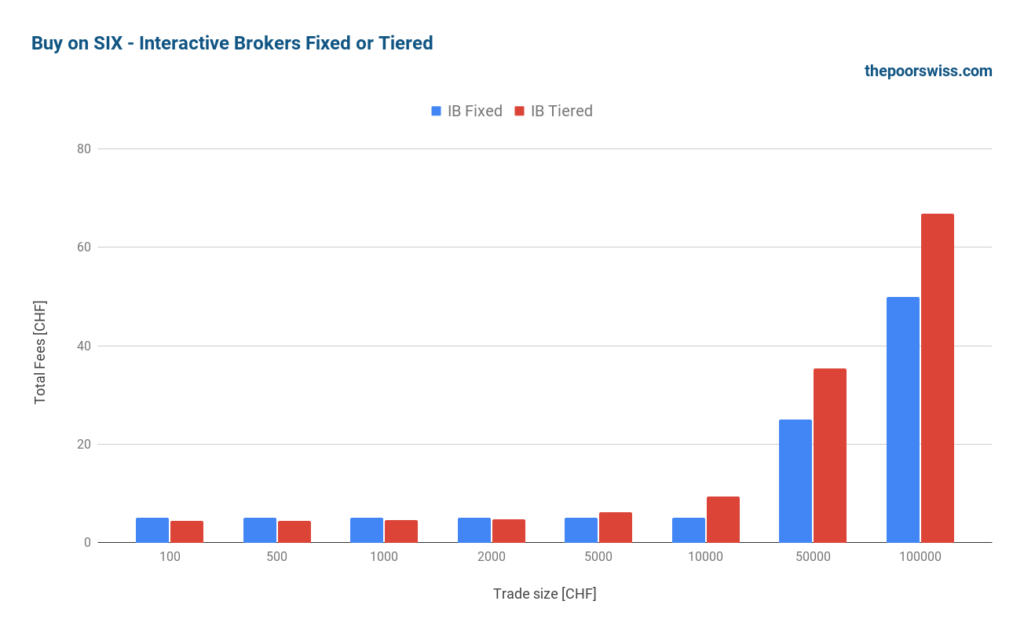
These results are pretty interesting. We can see that for small operations, the tiered pricing is slightly cheaper than fixed pricing. But once we reach 5000 CHF orders, fixed pricing becomes cheaper. And as order sizes increase, the gap between both pricing schemes grows.
So, to buy on SIX, you should use tiered pricing for small operations and fixed pricing once you start doing large options.
European Stock Exchange (Euronext)
Next, we look at the Euronext Paris stock exchange, one of the most used stock exchanges for European investors.
With fixed pricing, you will pay 0.05% of the trade value on Euronext Paris, with a minimum of 3 EUR and no maximum.
With tiered pricing, you will pay 0.05% of the trade value on SIX, with a minimum of 1.25 EUR and a maximum of 29 EUR. After that, you must pay exchange fees of 0.006% of the trade value, with a minimum of 0.75 EUR and no maximum. You also have to pay a clearing fee of 0.10 EUR.
Once again, here are the total fees for a few order sizes:
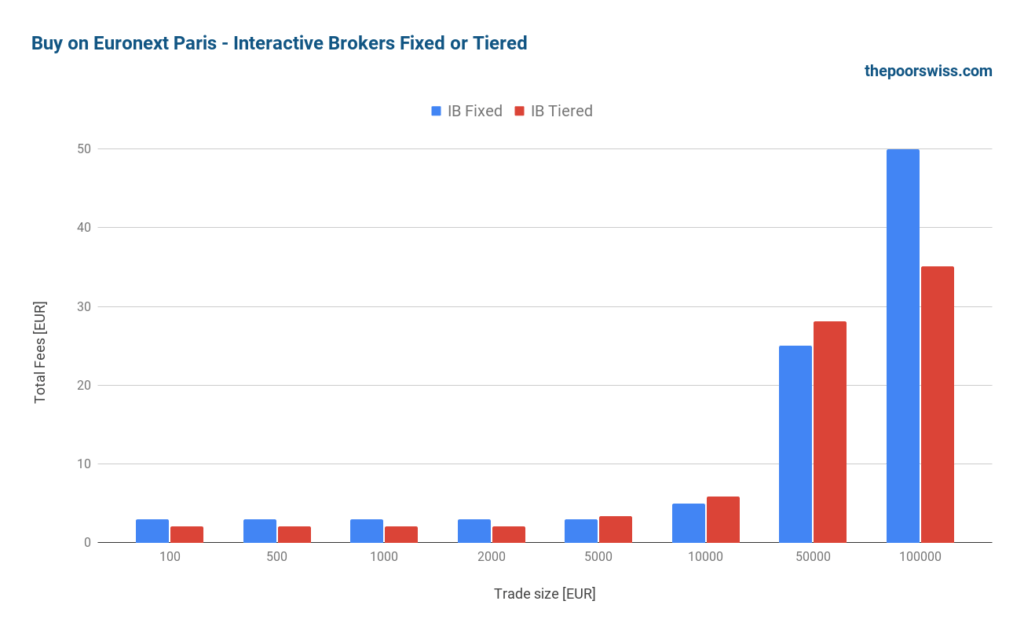
These results are very interesting. Below 5000 EUR, the tiered pricing is cheaper than the fixed pricing. Indeed, the tiered pricing minimum is smaller. Then, between 5000 and 50’000 EUR, fixed pricing is slightly more affordable. Finally, for 100’000 EUR, tiered pricing is cheaper again. Indeed, there is a maximum for the commissions, while fixed pricing has no maximum for the commissions.
So, to buy on Euronext Paris, you should start using tiered pricing for small operations, Fixed pricing for medium operations, and, once again, tiered pricing for large operations.
New York Stock Exchange (NYSE)
Finally, we should look at the New York Stock Exchange (NYSE), the stock exchange of the best ETFs available.
Interestingly, the commissions on NYSE are expressed per share. For this, I will assume that we buy an ETF with shares worth 100 USD. So, if we buy 1000 USD, we buy ten shares.
Also interesting is that this time, the fees differ between buying and selling. So, we first cover the buying fees.
With fixed pricing, you will pay 0.005 USD per share, with a minimum fee of 1 USD and a maximum fee of 1% of the trade value.
With tiered pricing, you will pay 0.0035 USD per share on NYSE, with a minimum fee of 0.35 USD and a maximum fee of 1% of the trade value. Additionally, you have to pay a clearing fee of 0.0002 per share. You will also pay an NYSE exchange fee of 0.003 per share. Finally, you will pay some pass-through fees. For NYSE, these pass-through fees are 0.000175 times the total of the other fees.
Putting it together, this gives us these fees for buying on NYSE:
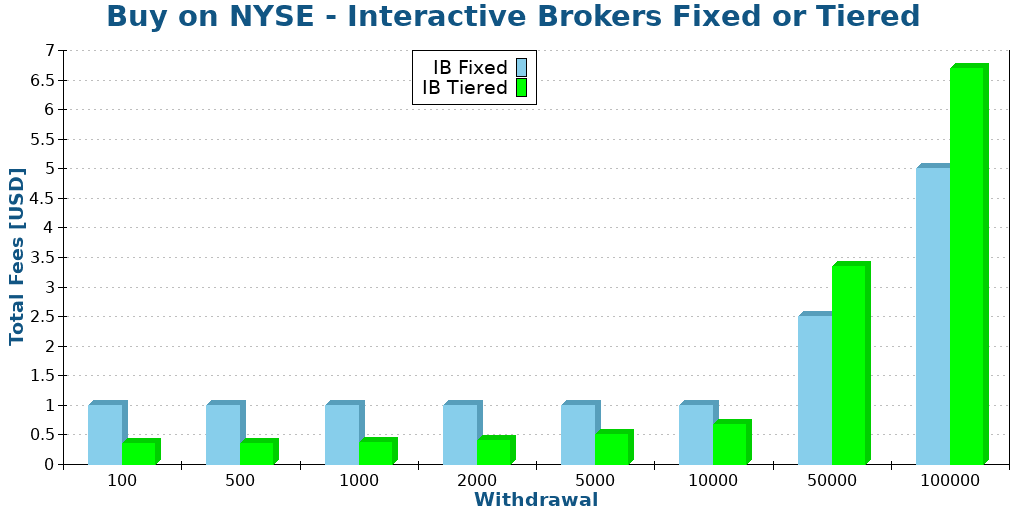
Interestingly, Interactive Brokers’ tiered pricing is cheaper for all operations below 50’000 USD but start to be slightly more expensive for larger operations. For small operations, tiered pricing is almost three times cheaper. However, it is worth mentioning that both pricing models are extremely cheap for US ETFs.
For sale operations, there are two additional regulatory fees:
- The SEC regulatory fee of 0.0000229 per share
- The FINRA regulatory fee of 0.00013 per share, with a maximum of 6.49 USD
These two regulatory fees apply to both fixed and tiered pricing. So, this will not change which model is cheaper, but it is still interesting to realize the prices.
So, here is how this translates to selling on NYSE:
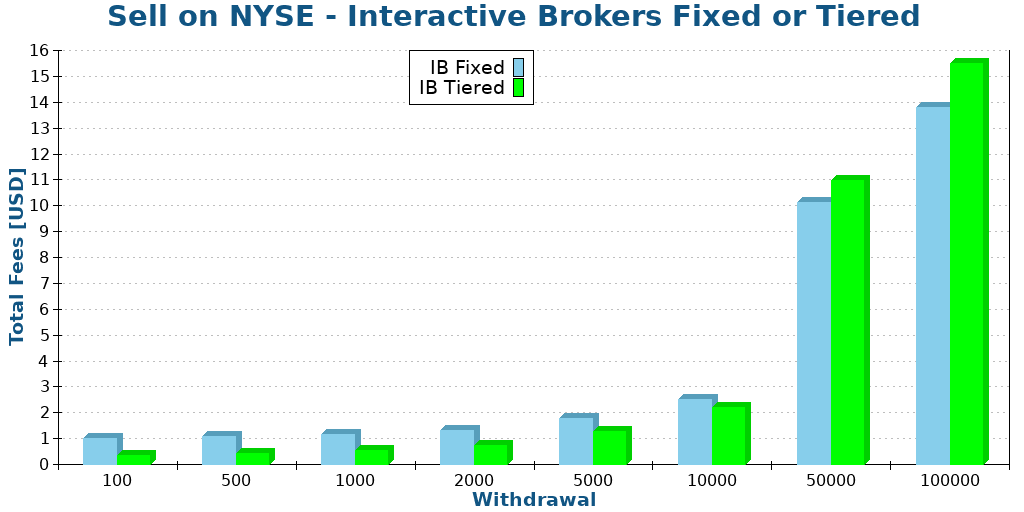
The tiered pricing model is generally the cheapest, up to very large operations. The gap is slightly smaller than for buy operations. However, the selling fees weigh heavily on large operations that are now several times more expensive.
For most passive investors, having more expensive sales should not be an issue. Indeed, we should buy more often than we sell.
For a small conclusion on US stock exchanges: Tiered pricing is cheaper than fixed pricing to buy US ETFs on NYSE.
Conclusion
The broker you need to buy stocks and ETFs reliably and at extremely affordable prices. Trade U.S. stocks for as little as 0.5 USD!
- Extremely affordable
- Wide range of investing instruments
We can see that neither fixed nor tiered pricing is always the cheapest option. It depends on which stock exchange you use and on the size of your transactions.
If you mainly buy US ETFs, you should use tiered pricing to save money. If you do small operations, tiered pricing is also great. Fixed pricing is excellent for medium to large operations on Swiss and European stock exchanges.
We must mention one more thing: fixed and tiered pricing models are affordable. Interactive Brokers has excellent pricing! Given these results, I plan to keep tiered pricing because I mostly use US ETFs.
What about you? Are you using Fixed or Tiered pricing?
Download this e-book and optimize your finances and save money by using the best financial services available in Switzerland!
Download The FREE e-bookRecommended reading
- More articles about Best Brokers
- More articles about Investing
- Cornèrtrader Review 2024 – Cheapest Swiss broker
- The best broker for Swiss investors in 2024
- How do commission-free brokers make money?

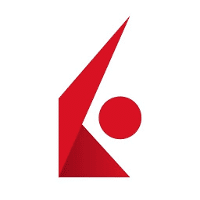
Thank you Baptiste for your article on Interactive Brokers tiered vs fixed.
I am still confused on the exact price point when we should switch from Tiered Pricing to Fixed Pricing when purchasing VWRA etf.
Is there a particular trade value where it is cheaper to switch to Fixed Pricing? For example if the trade value is over 5000 USD would it be cheaper to switch to Fixed Pricing?
HI Abruzzo,
I have not computed the breaking point for VWRA, on London Stock Exchange.
Given that the difference is very small generally and that I trade mostly in US ETFs, I do not bother changing for each operation. I use tiered pricing everywhere so that I save money on average and I don’t look at each operation.
If you want to do the math for UK, you can check it here https://www.interactivebrokers.com/en/pricing/commissions-stocks-europe.php?re=europe
Thank you for your great work!
Do you have data for NASDAQ in the US? I wonder if it would differ much from the NYSE results.
Kind regards
I have not done all the math, but the data is available online for each stock exchange: https://www.interactivebrokers.com/en/pricing/commissions-stocks.php?re=amer
The difference will be very little because we mostly hit the minimum unless we do very large operations.
I just opened an Interactive Brokers account. For a frequent/active trader only trading US stocks, do you think the fixed or tiered commission structure will be cheaper?
Thank you so much in advance for your input/ explanation.
🙏
If you frequently trade small transactions, tiered will be better but as the volumes grow fixed may be better. But I have never studied active trading, so you’ll have to run the maths for your case.
Quick question about IBKR fees for European bonds.
I read about it and it seems there is a 0.1% fees from IBKR based on trade value. Then there is some fees from Euronext which is 0.045% (min 2 EUR) and 0.1 Euro clearing fees.
So for example, if I want to buy 6000 Euro worth German govt bonds in one shot, would total fees be 8.8 Euro or should I expect some other fees on top?
IBKR commission = 0.1% of 6000 = 6 Euros
Euronext fees = 0.045% of 6000 = 2.7 Euros
Clearing fees = 0.1 Euro
Total = 8.8 Euro
I am not sure if there is any other fees that I am not aware of.
Link below shows some strange costs
https://www.interactivebrokers.co.uk/en/accounts/fees/commissionExamples.php
It seems correct, but I have seen 0.0425% for Euronext, which saves you 0.15 EUR, for 8.65 EUR.
I believe there should be no other fees.
For bonds, this should be the reference pricing page: https://www.interactivebrokers.co.uk/en/pricing/commissions-bonds-europe.php?re=europe
It looks like the page you linked is for a regular investment of 10K per month. And it cites some market research fees that you do not need.
Thank you Baptiste for all your amazing guides on your website, it’s absolutely insane how cheap IB is compared to other online brokers. I transfered 10k CHF, exchanged them to USD and got an even better exchange than google said with only a fee of 2$ (Wise would have been ~50$ fee). Then I bought 27 US-ETFs “IVV” and the commission was only 0.31$ (!). Wish I would have discovered it earlier, but better late than never ;-)
Hi Jay,
Yes, for a Swiss investor investing in US ETFs, IB is excellent!
Good luck for your investing!
Dear Baptiste,
Hope this email finds you well.
I am a non-swiss/non-european but residing in switzerland (I am planning to stay in CH for long time).
I am looking to open an IB account since I am planning to invest in US-ETFs and I was wondering if you would recommend me to open my IB account in CH or USD? (I get paid in CH)
Thank you in advance, your blog is a great guide!
Hi Kevin,
It does not matter much. What you choose is the display currency. Even if you choose CHF, you can still have USD and even receive USD (I do it sometimes).
But if you live in Switzerland, I would still recommend CHF.
Great article Baptiste.
Something worth mentioning could be the rebate fees you get when you add liquidity on exchanges that IBKR offers to you even it’s really minor in absolute numbers.
For example on NYSE, https://www.interactivebrokers.com/en/accounts/fees/NYSEstkfee.php
That’s why it’s even possible to pay lower than the “minimum fee of 0.35 USD” in practice when placing small orders for example.
Hi,
It’s true that this could get you lower than 0.35 USD, however the rebates are so small it barely makes a difference. Do you think it’s really worth mentioning?
I’m with IB since 2018 and have asked myself this question many times.
So far, I used only tiered pricing.
I cannot follow your calculations for SIX. Just last week, I bought a Swiss ETF on SIX for CHF 6,500. Fee: CHF 3.27.
Two days later I bought the same ETF for CHF 6,400. Fee: CHF 6.40. Second transaction was executed in two parts, which apparently increased the fee. I find this quite irritating since I have no control over how IB executes my order.
What is your experience in ‘real life’? If your order gets executed in two parts, do you pay the CHF 5 under the fixed pricing model twice?
Hi,
Interesting, I will need to check the numbers out again.
But I have never seen the same situation you show. My prices are about 6.50, more than 3. Depending on the app you use, you may be able to tell IB to only execute the order as a single lot.
I am only using the tiered pricing, so I don’t know if this can happen with fixed. But I am guessing the system is more or less the same.
In any case, the best way to save money on trading fees is to trade once a month :)
If you log in to TWS, you have option to select “all or nothing” for a trade. In such scenario, system will either buy all or nothing, if the volume will not be sufficient. This way you can avoid splitting your order (but also, for not very liquid trades or with big price moves, you may miss the trade and will have to reinsert the order)
Would your conclusion apply to stocks bought on the New York Exchange as well or is it only applicable to ETFS?
Thanks
There could be slight differences, but in this case, yes, the conclusions would hold :)
How can one change the pricing scheme in IB?
Good question, you can find out in my article about creating an IB account.
in account settings, top right corner, then you go to settings.
Dumb question….
Can we change pricing how many times we want?
If so, then one can buy on NYSE with tiered pricing, then when later buying on SIX one changes to fix pricing, then bigger transaction size, change back to tier and so on…
I can see this turning into a rather funny “game”.
Are there any terms against this or limited number of changes to the pricing scheme to be used?
Hi mihai,
I am not sure but I would say this would likely go against fair use of IBKR.
When you change your pricing method, it takes usually a day to apply. This may have to be approved by someone (or some automated process). So, in theory, you may do transactions each day on a different pricing model. But you may also be flagged by the system.